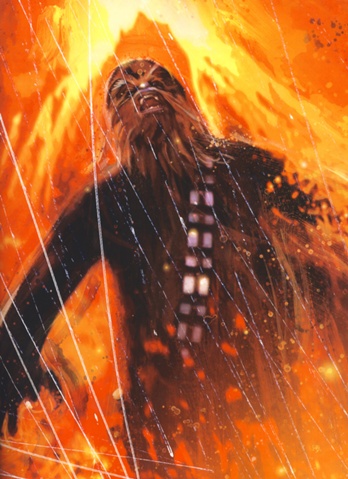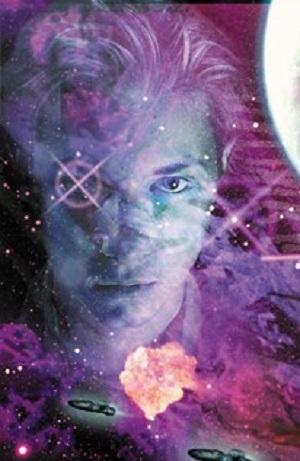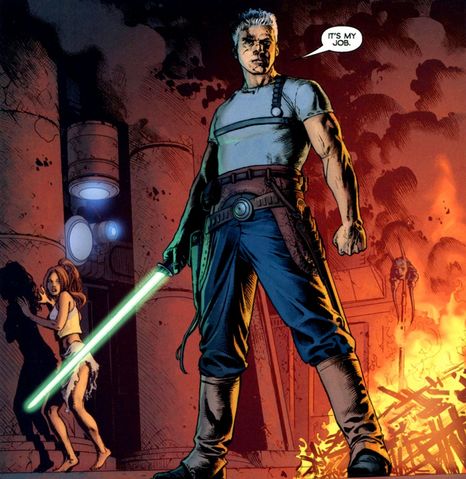 With apologies to Roxy Music’s “Love Is The Drug”:
With apologies to Roxy Music’s “Love Is The Drug”:
Death is the drug I’m thinking of
Oh oh can’t you see
Death is the drug for me
Death as a story device is one that goes all the way back, it’s always been used in tales – but has it always been expected ahead of a tale? Over the last fifteen years there has been a shift from death as story device and surprise to anticipating character deaths before a story is released and even requiring stories to have character deaths. Is this always beneficial and is it always warranted?
In terms of how to approach a story, bringing the death aspect to the fore tends to be to that story’s detriment, as the death eclipses all else. Vector Prime is not the book that started the Vong invasion, it’s the book that killed Chewie! After that Del Rey were, in a way, locked into killing someone else, which they did two years later in Star by Star with Anakin Solo. An unwitting consequence of these acts was the creation of a ‘who will they kill next’ line of thought. The answer to that turned out to be another Solo kid, more Jedi, another Chief of State, several of Luke’s old girlfriends and I’ve likely missed a few.
Arguably more than anything else, although sheer plot artifice has to be a strong contender, a slaughterhouse of character carnage came to define the Denningverse. Ahead of Legacy of the Force: Sacrifice, much speculation was around the fact that Mara Jade was occupying the ‘death spot’ on the cover, therefore could Jade be for the chop? Could it be a cunning double bluff? Alas, DR at that time didn’t really do that, Mara Jade did indeed die, badly.
It’s notable that the death scenes that people respond badly to are the ones that do not really work or are obviously contrived by the plot. Rarely will you hear much said about the death of Ganner Rhysode other than it was frigging awesome. Kol Skywalker? Walking death to about twenty Sith before going down. Chewie? Dropping a moon on him felt like the worst kind of overkill and looked to be plot mandated, similarly Anakin Solo, with the teenage suicide mission plot. That, and people did see it coming, still did not like it but speculation around the death of “Jimmy” preceded Star by Star‘s release.
 With the exception of something like Babylon 5’s “Sleeping in Light”, death as a story device works best when the reader does not see it coming. There are no clues, no indicators, no redshirt tag or suspicious character development for a character that had little previously. No, death works best in stories when it just happens and whacks the reader in the guts. The Legends example for that was Ton Phanan, no one saw it coming and if they had it would have been woefully diminished.
With the exception of something like Babylon 5’s “Sleeping in Light”, death as a story device works best when the reader does not see it coming. There are no clues, no indicators, no redshirt tag or suspicious character development for a character that had little previously. No, death works best in stories when it just happens and whacks the reader in the guts. The Legends example for that was Ton Phanan, no one saw it coming and if they had it would have been woefully diminished.
Another notion that has come along is that the if no one close to the lead character dies, then the story is not realistic enough. The problem here is that this elevates the fact that people die in war to such a degree that its opposite is forgotten, that people live through wars and survive them. They do not come through them unscathed in any respect whatsoever, but they are alive at the end.
The recent book Heir to the Jedi triggered a firestorm of criticism in killing off one of its lead characters at the end. Part of the criticism was around the type of character, person of colour and female, who was also a sharpshooter sniper! A rare combination, an interesting character many would have liked to see more of. Too bad, she’s dead Jim! The other aspect was that her death was “needed” for Luke to grow, which invokes the Fridge of Female Death – and yes, way back when a character’s girlfriend was killed, dismembered and her bleeding parts stuck in a fridge! No joke, that was done. The very same point was made with regard to Mara Jade’s death too. The shame of it is that, up to that point, Heir to the Jedi was not a deadly serious book. It’s quite light-hearted, with occasional moments of tension and battle, which only makes its final scenes more aberrant.
What it also brings to the fore is why people read series like SW in the first place and that tends to be to follow characters. That is follow them as they live and develop, not into the grave. Short of writing in the worlds of DC or Marvel Comics, with their numerous escape doors built in, character deaths are indeed final. It is likely for this reason that a couple of series have mostly defied the expectation of death on the part of the reader.
The Coruscant Nights series, mostly, kept a gang of characters together but did in its last book, also opt for the Fridge of Female Death move, killing off a Jedi gunslinger. The thinking then was Vader had to be proven a bad-arse by killing someone, apparently dominating the entire plot and having everyone react to what he did was insufficient. The fun part of the series is following the characters from book to book which cannot happen if they are corpses.
DHC’s Dark Times defied reader expectations by not killing off lead characters, but then, in its first arc, did something incredibly vicious to one of its lead characters. Instead of killing him, it had his family captured, sold and the buyer then ate them! No one saw that one  coming. In contrast, for what became its final arc, mucho death was justifiably expected but not delivered. The death it did have was not the one that the story had, for many, been leading to. Instead, a weird sideways move into a blatantly transparent romance switched around who got Death by Vader. That had the unfortunate effect of tarnishing the series right at the end which was a shame.
coming. In contrast, for what became its final arc, mucho death was justifiably expected but not delivered. The death it did have was not the one that the story had, for many, been leading to. Instead, a weird sideways move into a blatantly transparent romance switched around who got Death by Vader. That had the unfortunate effect of tarnishing the series right at the end which was a shame.
So how should death be done? Here I’d say the films offer some excellent guidance. The deaths happen but are not permitted to define the narrative, they are part of the story, but not the whole of it. For all the plaudits it gets, The Empire Strikes Back fails the death requirement! It puts the characters through the wringer but doesn’t actually kill anyone. Instead it settles for maiming! Yet, the audience gets so ensnared by the way it tells its story that they neither notice or mind about this.
Perhaps in the end, there’s only one rule for stories and that’s that there are no rules! Authors should not shrink from killing a character off, but neither should they feel required to – especially if they can invoke a sufficient sense of suspense in the reader merely by suggesting it may be possible. In this respect Luke Skywalker and the Shadows of Mindor and Shatterpoint are the examples to look to, both by one Matthew Stover strangely enough, hmm, has to be a coincidence surely? On the audience’s side the rule is equally simple, go in with expectations of a good time but do not let those expectations try to pre-empt the story. The audience is not, nor should try to be the driver, they are instead the passengers on a roller-coaster ride and really shouldn’t have time to contemplate anything but the present moment! This also has the benefit of weaning the audience off the death drug!

My thoughts upon character death is this: does it make the story/universe better? Obi-wan dying — that makes the story/universe better. The mentor sacrificing himself sets up lots of themes. Chewie dying – it didn’t make the story better. Instead of highlighting the dangers of the Vong invasion, it ruined Han Solo for how many books… not an improvement to the universe — especially when it wasn’t an act of self-sacrifice on Chewie’s part.
A second thought: If a character is going to be written out of the series, you don’t want major characters dying because of something stupid. You don’t want Anakin dying because the 15 year old is the ideal person to lead the strike team (who then dies to provide a chance for the team to escape… which they ignore when they fight to recover his body… because… yeah). You don’t want Mara Jade dying because she sneaks off in the middle of the night to kill her nephew. Those aren’t “good” ways to go out.
Now, if you had Luke and Mara confront Jacen, and Jacen had somehow incapacitated Luke, and Mara jumps in the way, takes the hit and damages Jacen enough to drive him off but then dies… it has a totally different feel to it. So many of the deaths have been hamfisted – they haven’t been “Ganner” style.
Definitely way too much death going on in NJO and beyond, or at least death without a good narrative fit. It seemed to me that a lot of the non-Mara and Chewie deaths were because they did such a bad job of passing the torch (especially after NJO) that they just had to get rid of characters to have a reason to keep the older generation of heroes in the spotlight.
One character death that I thought had potential but fell flat was Nelani Dinn. Even reading as a teenager, I knew that she would be a throwaway character, given the direction Jacen was going. To me, they introduced this new character solely for the purpose of really solidifying the journey of Jacen’s fall. If you absolutely needed that death, why not use an established character that could have been used to better effect? What if it had been Tahiri inserted in the role instead? She had already received a decent amount of screen time in NJO, so it wouldn’t seem contrived that she was thrust into the spotlight. We still would have that this is Jacen’s commitment to learning more about the dark side and that there is a young Jedi there that tries to stop him from going down this path whom he has to kill in order to keep Lumiya a secret. Also, it saves us from Tahiri’s character direction later on in the books.
A related topic was with the new Avengers movie. I stopped following the production right when the teasing about an Avenger being killed off started to surface. My initial guess was wrong, but going in expecting someone to die had me feeling slightly cheated for some of the movie.